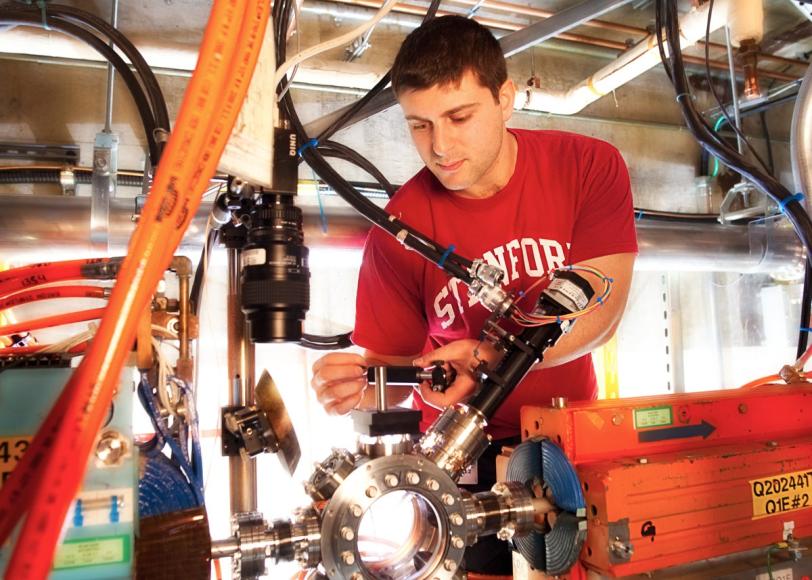Spencer Gessner Receives 2014 Siemann Fellowship
Stanford graduate student Spencer Gessner has received a Siemann fellowship to help him continue his research into cutting-edge accelerator physics at SLAC's Facility for Advanced Accelerator Experimental Tests.
By Lori Ann White
Spencer Gessner, a Stanford graduate student in physics, has been chosen as the third recipient of the Robert H. Siemann Graduate Fellowship in Physics. Established in memory of long-time SLAC accelerator physicist and Stanford faculty member Robert Siemann, the fellowship provides funding to outstanding graduate students who do accelerator physics research at SLAC.
Like many hard-working SLAC graduate students, Gessner leads something of a double life: As a SLAC employee he is a member of the team that keeps the Facility for Advanced Accelerator Experimental Tests (FACET) running and helps users who come to take advantage of its unique capabilities. As a graduate student, Gessner is "doing science." He studies plasma wakefield acceleration, or PWFA, a promising technique for boosting particle beams that could make future accelerators more powerful and efficient and far less expensive.
Gessner is doing a great job in both his lives, said Mark Hogan, head of SLAC's PWFA team.
"Spencer is extremely bright and enthusiastic," said Hogan. "But what marks him as a scientist is that he's intensely curious. His drive, his motivation, his persistence, his hard work – it all comes from his curiosity about the natural world."
A native of New York, Gessner made his way west to California for his undergraduate studies at University of California, Santa Barbara, which appealed to him as much for its stellar physics program as for its milder weather – although, said Gessner, "I did learn to surf my last year there."
Stanford and SLAC also beckoned for a multitude of reasons when Gessner considered where to attend graduate school. "Stanford has a wide range of physics opportunities, both theory and experiment, at SLAC and on campus," he said. Once at Stanford he spent a summer studying at CERN, the European particle physics center, where working on the ATLAS detector showed him where his future in physics lay.
"I decided I wanted to do something hands-on," he said, and his experience at FACET has only served to show he made the right decision.
"The actual work I do at FACET is a lot of fun," said Gessner. "One day I'm in the tunnel building something, then I'm in the Main Control Center running the beam, then maybe I'm doing data analysis. I want to do research for as long as possible."
He is working on a technique called hollow channel plasma wakefield acceleration, in which a high-intensity laser beam shot straight through a gas ionizes the gas to create a plasma tunnel. Electromagnetic fields in the plasma accelerate particles going through the tunnel.
"We want to understand the physics of a hollow channel accelerator for both electrons and positrons," he said, and electrons are up first, with an experiment planned for the current FACET run.
"Spencer is doing an excellent job," said Tor Raubenheimer, SLAC professor of particle physics and astrophysics and Gessner's advisor. "He's tackling one of the most challenging problems in plasma acceleration, one which must be solved if the technique is to ever be used as the basis for an electron-positron collider in high energy physics."
Gessner thanked Siemann's widow Hannah, who endowed the fellowship. "She really believes in this kind of research and wants to stay involved," he said.
SLAC, Stanford and Hannah Siemann welcome additional contributions to the Robert H. Siemann Graduate Fellowship in Physics (fund KAAWY). Contributions may be made by check to:
Stanford University
c/o Ruth Cinquini Richerson, Associate Director of Development
326 Galvez St.
Stanford, CA 94305-5018
About SLAC
SLAC is a multi-program laboratory exploring frontier questions in photon science, astrophysics, particle physics and accelerator research. Located in Menlo Park, California, SLAC is operated by Stanford University for the U.S. Department of Energy Office of Science. To learn more, please visit www.slac.stanford.edu.
DOE’s Office of Science is the single largest supporter of basic research in the physical sciences in the United States, and is working to address some of the most pressing challenges of our time. For more information, please visit science.energy.gov.






